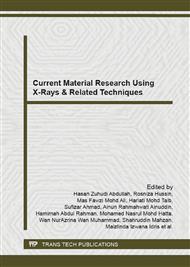p.443
p.447
p.452
p.457
p.460
p.465
p.470
p.475
p.479
Formation of Aligned Iron Oxide Nanopores as Cr Adsorbent Material
Abstract:
Elongated iron oxide nanopores (FNPs) were fabricated by anodisation of iron in fluoride-ethylene glycol (EG) added to it 1 ml, 1 M KOH electrolyte at three different voltages: 30 V, 40 V and 50 V. It was observed regardless of the voltage applied; the nanopores seem to be separated from one to another at the bottom part of the anodic film forming rather discreet nanotubular structure at this region. X-ray diffraction (XRD) was used to evaluate the phases present within the anodic layer. γ-FeOOH, Fe (OH)2, and FeF5.H2O were detected in all samples. However, when the anodisation voltage was increased, peaks from the FeF5.H2O are more intense indicating either more F- insertion in the anodic layer or crystallization of this phase at higher voltage. After annealing, XRD detected only hematite; α-Fe2O3 and magnetite; Fe3O4 indicative of phase formation or transformation had occurred during the annealing process. The annealed samples displayed an ability to adsorb Cr (VI) with almost 30 % reduction of the Cr (VI) concentration after 5 hours of exposure to the nanoporous anodic film.
Info:
Periodical:
Pages:
460-464
Citation:
Online since:
February 2015
Keywords:
Price:
Сopyright:
© 2015 Trans Tech Publications Ltd. All Rights Reserved
Share:
Citation:


